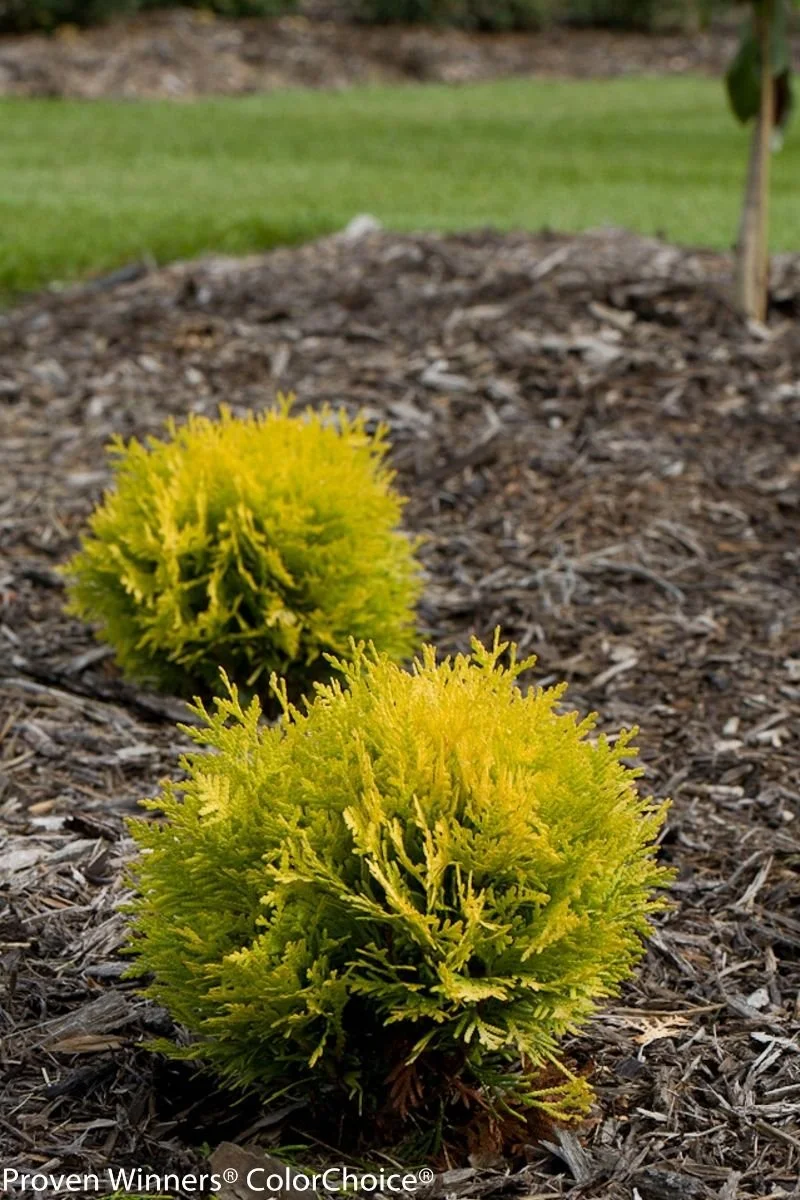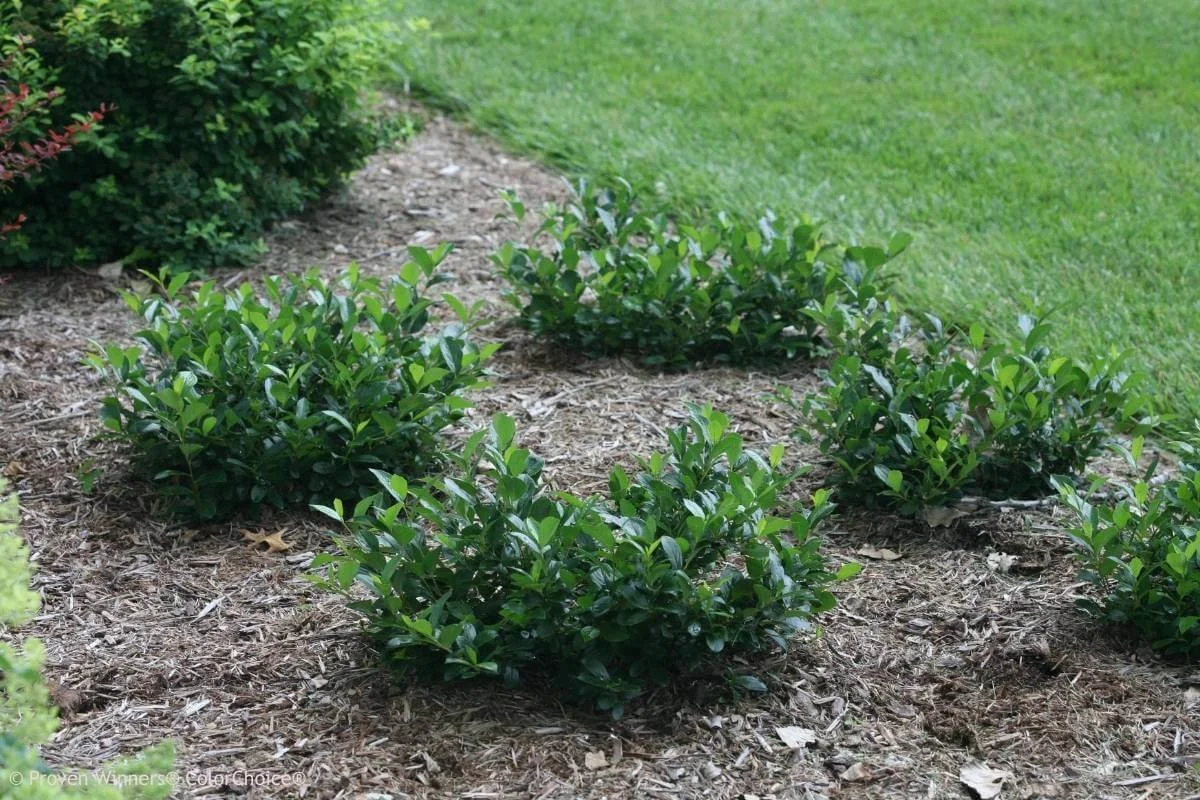10 Tidy Bushes for the Front of the House
Need ideas? Get help choosing shrubs for the landscaping in front of your house.
This post contains affiliate links, marked with an asterisk (*). If you click the link, I may receive a small commission at no extra cost to you - please see my policy on affiliate links. Thank you for supporting this blog!
When I design with bushes in the front of the house, I like to choose tidy, structured plants that lend a polished look for long periods of time.
The best bushes for the front of the house are either evergreen, long-blooming, or have interesting foliage. Some plants even have a combination of these traits!
A well-planned landscaping design not only boosts curb appeal but also makes maintenance easier.
Keep on scrolling for ideas, pictures, and details, and don’t miss the expert tips at the end for buying, growing, and designing with your front of the house landscaping bushes.
1. Sprinter® Boxwood
Botanical name: Buxus microphylla 'Bulthouse'
Type: Evergreen shrub
Zones: 5-9
Light requirements: Full sun-part shade
Size: 2-4 feet high and wide
Attributes: Evergreen; deer-resistant; salt-tolerant; resistant to boxwood blight; fast growing; requires no trimming or pruning to maintain its shape.
Landscaping ideas: Foundation planting, lining driveways or walkways, hedging, delineating property lines, in containers flanking an entryway.
Sprinter Boxwood®. Image courtesy of Proven Winners, provenwinners.com.
Sprinter® Boxwood is an excellent choice for planting at the front of the house, offering a polished, classic look with its upright habit and glossy, deep green leaves.
Unlike many other boxwoods, Sprinter® grows fast, quickly filling in to create neat, formal lines or a soft and structured accent.
Its small evergreen leaves provide year-round interest and are easy to mix with flowering perennials and shrubs, making it a versatile foundation plant that elevates curb appeal in every season.
* Buy Sprinter® Boxwood from Fast Growing Trees*
2. Double Play Doozie® Spirea
Botanical name: Spiraea x 'NCSX2'
Type: Deciduous flowering shrub
Zones: 3-8
Light requirements: Full sun-part shade
Size: 2-3 feet high and wide
Attributes: Seedless and non-invasive; long season of bloom from early summer through frost; maintains a neat, mounded shape with no pruning required; no flower deadheading needed.
Landscaping ideas: Foundation planting, mass planting, island bed, border.
Double Play Doozie® Spirea. Image courtesy of Bailey Nurseries.
Double Play Doozie® Spirea is a standout choice for the front of the house, bringing bold color and effortless beauty all season long.
Its new leaves emerge a rich, deep red in spring, followed by vibrant blooms that last from late spring all the way through fall - you’ll be hard-pressed to find a shrub with a longer flowering season.
It’s also incredibly low-maintenance: no pruning required, deer tend to avoid it, and once it’s established, it handles dry spells like a pro.
Plus, because it’s seedless, there’s no need to worry about it spreading or becoming invasive. It’s the perfect way to add long-lasting curb appeal without the hassle!
* Buy Double Play Doozie Spirea from Fast Growing Trees*
3. Anna’s Magic Ball® Arborvitae
Botanical name: Thuja occidentalis 'Anna Van Vloten'
Type: Evergreen shrub
Zones: 3-8
Light requirements: Full sun
Size: 2-3 feet high and 3-4 feet wide
Attributes: Evergreen; maintains tight, rounded globe shape with no pruning required; native to North America; soft, bright yellow foliage; small size is easy to fit into urban gardens.
Landscaping ideas: Front of the border, lining low porches or low foundations, rock gardens, underneath low-set windows, or flanking shallow steps.
Anna’s Magic Ball® Arborvitae. Image courtesy of Bailey Nurseries.
Anna’s Magic Ball® Arborvitae is a charming and easy way to add year-round color and structure to the front of your house.
This petite evergreen naturally grows into a tight, rounded globe shape without any pruning, making it perfect for low-maintenance landscapes.
Its soft, bright yellow foliage stands out beautifully against darker green evergreens or adds a cheerful contrast to dark pink and purple flowers.
Native to North America and compact in size, it’s especially well-suited for urban gardens or small spaces where you want a pop of color and tidy form with zero fuss.
The globe-shaped Anna’s Magic Ball® Arborvitae. Image courtesy of Proven Winners, provenwinners.com.
4. Suntastic® Pink Abelia
Botanical name: Abelia x grandiflora nana ‘Pink’
Type: Semi-evergreen flowering shrub
Zones: 6-11
Light requirements: Full sun
Size: 2-3 feet high and 4-5 feet wide
Attributes: Semi-evergreen; variegated foliage in shades of pink, white and cream; crimson stems; white flowers; long season of bloom from early summer through fall; butterfly favorite.
Landscaping ideas: Lining walkways and sidewalks, low-growing accent plant, mass plantings, filler for awkwardly shaped beds, containers.
Suntastic® Pink Abelia. Image courtesy of PlantHaven International, Inc.
Suntastic® Pink Abelia is a stunning, low-maintenance option for the front of the house, offering a mix of beauty and easy care.
Its semi-evergreen foliage is variegated in soft shades of pink, white, and cream, accented by eye-catching crimson stems that add extra visual interest.
In early summer, it begins to bloom with delicate white flowers that continue all the way into fall, making it a long-lasting source of color and charm.
Butterflies love it, and you’ll love how little work it needs - no fuss, just season after season of vibrant, reliable beauty!
5. Uptight Boxwood
Botanical name: Buxus microphylla ‘Robbuxupt’
Type: Evergreen shrub
Zones: 5-9
Light requirements: Full sun to part shade
Size: 4-5 feet tall and 2-3 feet wide
Attributes: Evergreen; maintains narrow, upright, columnar shape with no pruning required; stays green throughout the winter with no bronzing; deer-resistant.
Landscaping ideas: Vertical accent for corners of the house, framing an entryway or garden gate, tall hedging, screening of utility boxes, trash cans or unwanted views (if used for screening, take note - it’s slow growing).
Uptight Boxwood. Image courtesy of PlantHaven International, Inc.
The Uptight Boxwood is the perfect choice for adding a bold, vertical accent to the front of your house.
Its narrow, upright shape makes it ideal for framing entryways, anchoring the corners of your home, or flanking a garden gate with clean, architectural style.
Uptight Boxwood also works beautifully as a tall hedge or as a natural screen to hide utility boxes, trash cans, or other unsightly views.
While it grows slowly - something to keep in mind if using it for screening - its tidy form and evergreen foliage provide year-round structure and elegance with very little maintenance.
6. Low Scape Mound® Aronia
Botanical name: Aronia melanocarpa 'UCONNAM165'
Type: Deciduous flowering shrub
Zones: 3-9
Light requirements: Full sun
Size: 18-36 inches tall and wide
Attributes: Delicate white spring flowers; glossy green leaves; brilliant red fall color; dark purple fruits; spreading ground cover; salt and drought tolerant; North American native
Landscaping ideas: Sidewalk or walkway edging, ground cover for irregularly shaped beds, mass planting, lawn replacement, front of the border, underneath low-set windows.
Low Scape Mound® Aronia is a low-growing ground cover shrub. Image courtesy of Proven Winners, provenwinners.com
Low Scape Mound® Aronia is a fantastic choice for the front of the house, especially under low windows or as a colorful, easy-care edging.
This North American native offers four seasons of beauty, starting with delicate white flowers in the spring, followed by glossy green foliage that turns brilliant red in the fall. It also produces dark purple fruits that add interest and attract wildlife.
Its low, mounded shape and spreading habit make it an excellent ground cover, and it’s both salt and drought tolerant - perfect for tough spots along driveways or walkways. Beautiful, resilient, and native - this low growing bush for the front of the house checks all the boxes!
*Buy Low Scape Mound Aronia (Chokeberry) from Fast Growing Trees *
Low Scape Mound® Aronia in autumn. Image courtesy of Proven Winners, provenwinners.com
7. Dwarf Japanese Cedar
Botanical name: Cryptomeria japonica ‘Globosa Nana’
Type: Evergreen shrub
Zones: 5-8
Light requirements: Full sun to part shade
Size: 4-5 feet high and 5-6 feet wide
Attributes: Soft, bright green foliage; rounded, compact shape; tidy habit; tolerates clay soil; deer-resistant; drought-tolerant once established.
Landscaping ideas: Evergreen specimen, mass planting, part of a mixed foundation planting, containers flanking an entryway.
Dwarf Japanese Cedar.
Dwarf Japanese Cedar is an excellent addition to the front of the house, bringing year-round beauty with its soft, bright green foliage and naturally rounded, compact shape.
Its tidy habit and slow growth mean it maintains its form without any pruning, making it a low-maintenance choice for homeowners.
Dwarf Japanese Cedar thrives in a variety of conditions, even clay soil, and is both deer-resistant and drought-tolerant once established.
Whether used as a striking evergreen specimen or tucked into a mixed planting, this charming shrub adds texture, color, and structure with minimal effort.
*Buy Dwarf Japanese Cedar from Fast Growing Trees *
8. Little Lime® Panicle Hydrangea
Botanical name: Hydrangea paniculata ‘Jane’
Type: Deciduous flowering shrub
Zones: 3-8
Light requirements: Full sun
Size: 3-5 feet tall and wide
Attributes: Flowers all summer long; reliable bloomer; lime green blooms turn white and later pink; strong stems won’t droop; sun-loving; compact size and shape.
Landscaping ideas: Foundation planting, low deciduous hedge, border, filling in areas underneath front porches or decks, containers.
Little Lime® Panicle Hydrangea. Image courtesy of Proven Winners, provenwinners.com
Little Lime® Panicle Hydrangea is a top pick for the front of the house, offering months of colorful blooms and a neat, compact shape that’s perfect for foundation plantings or brightening up spaces beneath front porches.
Its flowers start out a fresh lime green, gradually turning white and then soft pink as the season goes on—providing a beautiful, ever-changing display from summer into fall.
Unlike many hydrangeas, it thrives in full sun without wilting, and its strong stems keep the blooms upright and tidy. Easy to grow and incredibly reliable, Little Lime® brings beauty without the fuss.
*Buy Little Lime Hydrangea from Fast Growing Trees*
9. Daub’s Frosted Juniper
Botanical name: Juniperus x media 'Daub's Frosted'
Type: Evergreen shrub
Zones: 4-9
Light requirements: Full sun
Size: 12-18 inches high and 4-5 feet wide
Attributes: Evergreen; dynamic multi-hued foliage in shades of blue, green, and yellow; rugged, spreading nature; low-maintenance; deer-resistant; salt-tolerant.
Landscaping ideas: Groundcover, front of the border, filler plant for areas next to hot sidewalks and driveways, erosion control or no-mow ground cover on banks and slopes.
Daub’s Frosted Juniper. Image courtesy of Bailey Nurseries.
Daub’s Frosted Juniper is a colorful, low-maintenance evergreen that’s perfect for adding year-round interest to the front of the house.
Its spreading habit and vibrant foliage - blending shades of blue, green, and yellow - create a dynamic look that stands out in any season.
Rugged and dependable, it’s deer-resistant, salt-tolerant, and thrives with little care, making it ideal for edging walkways or filling in those tricky, irregularly shaped garden beds.
With its easygoing nature and eye-catching color, Daub’s Frosted Juniper brings both beauty and practicality to your landscape.
10. Lo & Behold® Blue Chip Jr. Butterfly Bush
Botanical name: Buddleia x ‘Blue Chip Jr.’
Type: Flowering shrub
Zones: 5-9
Light requirements: Full sun
Size: 18-30 inches high and 20-28 inches wide
Attributes: Sterile, non-invasive variety; small and compact size; long season of bloom all summer long; fragrant indigo purple flower spikes; butterfly magnet; drought-resistant once established; deer-resistant.
Landscaping ideas: Border garden, mass planting, edging along sidewalks and walkways, low deciduous hedge, specimen planting, containers, small front yards, next to hot driveways.
Lo & Behold® Blue Chip Jr. Butterfly Bush. Image courtesy of Proven Winners, provenwinners.com.
Lo & Behold® Blue Chip Jr. Butterfly Bush is a fantastic choice for the front of the house, especially in sunny, dry spots like along driveways or sidewalks.
This compact, non-invasive variety stays small and tidy, making it easy to tuck into foundation plantings or small garden beds.
It blooms all summer long with fragrant, indigo-purple flower spikes that attract butterflies in droves.
Drought-resistant once established and deer-resistant too, it’s a tough yet beautiful plant that brings vibrant color, pollinators, and sweet fragrance to your landscape - without taking over or needing much care.
*Buy Lo & Behold® Blue Chip Butterfly Bush from Fast Growing Trees*
Tips for Buying Bushes for the Front of the House
Choosing the right bushes for the front of your home starts with smart shopping! Here’s how to make sure you get exactly what you need:
Always purchase using the botanical name – Common names can be confusing and vary based on where you live. The botanical name ensures you’re getting the exact plant you want.
Ask for help if needed – A garden center overflowing with plants can feel overwhelming! Staff can guide you to the right place and answer any questions you may have.
If you're new to gardening – Not sure if your space is right for a particular plant? Bring photos of your yard to the garden center, and seasoned staff members may be able to help you determine if these front of the house bushes are a good fit for you.
Shop in early to mid-spring for the best selection – Many of these varieties are popular and tend to sell out quickly. Because plant supply can be unpredictable, once they’re gone, garden centers may not restock until the following year, so shop early to avoid disappointment!
By following these tips, you’ll have a better chance of snagging the perfect bushes for the front of the house, before they disappear from the shelves!
Tips for Growing Bushes in the Front of the House
Set your bushes up for success with these essential growing tips:
Select the right zone. Make sure the bushes you choose are suitable for your USDA hardiness zone.
Match the light requirements to the lighting conditions in the front your house. Ensure that your bushes thrive by choosing a spot with the correct amount of sunlight or shade.
Full sun plants thrive in 6+ hours of direct sunlight.
Part shade plants need 3–6 hours of sunlight or filtered light.
Water newly planted bushes properly. Keep the soil consistently moist but not soggy to help with the establishment of a strong root system. Read “How to Water Your Plants” for help in determining your watering strategy.
Monitor drought conditions. Visit the US Drought Monitor map to see if your area is currently experiencing a drought.
By following these tips, you’ll help your bushes thrive all season long!
Design Strategies for The Front of the House
Measure & Plan Ahead: Take measurements of garden beds and foundation areas before heading to the nursery. This ensures you buy the right number of plants for your space.
Mind the Spacing & Mature Size: Always consider a plant’s mature size before choosing its location. Planting too close to the house, the driveway, or a pathway can lead to problems over time. Plan ahead to avoid common issues like blocked windows, crowded entryways, and narrow, overgrown walkways.
Consider Color Harmony: Make sure your plant choices complement the existing colors of your home. For example, pink flowers or lime green foliage may clash with muted, orange-toned brick houses and walkways. I use a color wheel for my designs, but in a pinch, I compare plant photos on my phone against brick, siding, or door colors.
Incorporate Evergreen Structure: Evergreens provide year-round greenery and structure, keeping your front yard visually appealing, even in winter time.
Think About Traffic Flow: Be mindful of how you and others move around your property. Don't interfere with someone’s ability to exit a car comfortably, don’t block frequently used pathways, and don’t infringe on areas where trash cans are stored.
Don’t Forget Our Canine Friends: Do you have a sidewalk along the front of your property, and lots of neighborhood dogs? Beware - any shrubs planted too close to the sidewalk might become, well… the local potty stop. Repeated exposure to dog urine can cause unsightly yellowing leaves and may eventually kill your plants. Sad but true, I’ve seen it happen many times! If this sounds like a possible issue, your best bet is to plant further back from the sidewalk or skip planting in that area altogether.
Follow Plant and Bloom Design Studio for More Garden Ideas












